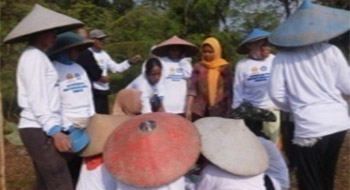Pemberdayaan Wanita Tani dalam Budidaya Kedelai Varietas Unggul Bahan Baku Pembuatan Tahu
Abstract
WOMEN FARMERS EMPOWERMENT IN SOYBEAN CULTIVATION OF SUPERIOR VARIETIES RAW MATERIAL OF TOFU PRODUCTION.
Soybean is one of the important crops containing high protein content. The demand of soybean increases from year to year, because the domestic production could not reach the market demand and it is still imported. Therefore, the necessary effort to increase soybean production must be done such as by expanding the planting area, planting superior varieties especially for raw materials of tofu, and the cultivation techniques. Sumedang is one of the centers of tofu production in West Java that has the suitable agro-climatic conditions for soybeanproduction as a raw material. Some of the farm communities have cultivated soybeans, however they still needs the efforts to increase the soybean production especially for the types of soybean for raw material of tofu production. The aim of IbM activity is to socialize and make a pilot demonstration plot of some of superior soybean varieties for tofu production in Sumedang. The results of these activities include: (1) the demonstration plots of soybean varieties, (2) producing the high seed quality of superior soybean varieties, (3) improving skill and knowledge of farmers in the cultivation of superior soybean varieties and also pest and disease control, (4) obtaining the samples of tofu from superior soybean varieties grown in partner locations.
References
Balitbang Pertanian. (2014). Laporan tahunan 2013: Inovasi teknologi pertanian ramah lingkungan dan berdaya saing. Jakarta: IAARD Press.
BPS. (2013). Produksi padi, jagung, dan kedelai (Angka ramalan 1 tahun 2013). Retrieved January 31, 2014 from http://www.bps.go.id/brs_file/aram_01jul13.pdf.
Direktorat Jenderal Tanaman Pangan. (2013). upaya-upaya khusus percepatan program pengembangan kedelai tahun 2013. Jakarta: Kementerian Pertanian Republik Indonesia.
Elfiani, E., & Jakoni, J. (2017). Pengujian daya berkecambah benih dan evaluasi struktur kecambah benih. DINAMIKA PERTANIAN, 30(1), 45-52.
FAOSTAT. (2012). Database food and agriculture organization of the united nation. Retrieved January 31, 2014 from http://faostat.fao.org/site/340/DesktopDefaulth.aspx?PageID=340.
Ilyas, S. (2012). Ilmu dan teknologi benih: Teori dan hasil-hasil penelitian. Bogor: IPB Press.
Kementerian Perdagangan. (2015). Laporan akhir: Kajıan efektivitas kebijakan impor produk pangan dalam rangka stabilisasi harga. Jakarta: Puska Daglu, BP2KP, Kementerian Perdagangan RI.
Krisdiana, R. (2015). Preferensi industri tahu dan tempe terhadap ukuran dan warna biji kedelai. Iptek Tanaman Pangan, 2(1), 123-130.
Mulyani, A., Rachma, A., & Dairah, A. (2010). Penyebaran lahan masam potensi dan ketersediaannya untuk pengembangan pertanian. Bogor: Balai Penelitian Tanah (Balittanah).
Pawiroharsono, S. (2012). The role of biotechnology for improvement of soybean production in sub-optimal land. Widyariset, 15(3), 665-672.
Sudaryanto, T., & Swastika, D. K. (2007). Ekonomi kedelai di Indonesia. Forum Agro Ekonomi (FAE), 12(3), 1-27.
Sumarno. (2011). Membuka lahan baru “kunci untuk swasembada kedelai”. Tabloid Sinar Tani, Edisi 30 Maret-5 April 2011.

Copyright (c) 2018 Erni Suminar, Wieny Marma Jaya, Rani Andriani Budi Kusumo, Syariful Mubarok

This work is licensed under a Creative Commons Attribution 4.0 International License.


